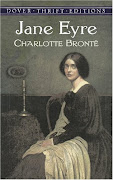Devotion in Jane Eyre, As I Lay Dying, and The Color Purple
Molly Ackerman
Devotion, by definition, is the “earnest attachment to a cause, person, etc.” (http://dictionary.reference.com/browse/devotion). However, particularly in literature, devotion can represent a variety of emotions and intentions. One can experience sincere devotion, conflicting devotion, unwanted devotion, even selfish devotion. Regardless of the type, devotion is a connection that links one person to something of great importance, whether it is another human, a time, a place, a memory, an inanimate object, or anything they feel bonded with. Jane Eyre by Charlotte Bronte, As I Lay Dying by William Faulkner, and The Color Purple by Alice Walker are all incredibly different novels, in theme, genre, and tone. However, they do share at least one common motif: devotion. The devotion illustrated in each of the three novels is by no means identical, or even similar. It is, nevertheless, devotion, and the comparative and contrastive uses suggest something significant about the word. Perhaps devotion, as a whole, can not be defined. But rather, it is something that requires further characterization and description in order to be truly understood.
On more than one occasion in Jane Eyre, a character is set up to make a difficult life decision that involves a choice between what is right and what is desired. As it is in a typical situation, the desired of the two is the one often felt most devotion towards. The strain to make a decision between the two is most justly characterized as conflicting devotion: when the object one feels devoted towards pulls them in a direction opposite the way they feel their life is supposed to travel. There is, most obviously, one character that falls at the hands of this struggle in the novel: Jane. The conflict of the entire novel, as well as the main problem of her life, is the decision between passion and sacrifice. Passion is, naturally, relative to devotion- and her passion is directed towards Rochester . She spends a part of the novel embracing her attraction, passion, devotion, yet at the moment a reason to abandon it is presented, she leaves, to live a life she feels obligated to. Her vow and obsession with living a selfless and divine life counteracts her desires and, vice versa. However, at the end of the novel, she is magnetized back to him. In chapter 32 of the novel, Jane confesses “…reader, to tell you all, in the midst of this calm, this useful existence- after a day passed in honourable exertion amongst my scholars, an evening spent in drawing or reading contentedly alone- I used to rush into strange dreams at night: dreams many-coloured, agitated, full of the ideal, the stirring, the stormy-dreams where, amidst unusual scenes, charged with adventure, with agitating risk and romantic chance, I still again and again met Mr. Rochester, always at some exciting crisis; and then the sense of being in his arms, hearing his voice, meeting his eye, touching his hand and cheek, loving him, being loved by him- the hope of passing a lifetime at his side, would be renewed, with all its first force and fire. Then I awoke.” No matter how hard Jane tries to escape indulgence, there is no escaping her devotion.
In As I Lay Dying by William Faulkner, a different sort of devotion is illustrated. Anse, the father and the most antagonistic character of the novel, devotes himself, his well being, and the well being of his children to burying his wife’s body in the ground. The journey to do so, is somewhat portrayed as Anse’s obedience to Addie’s dying wish. However, his persistence is a perfect example of selfish devotion: when one is obsessed with an object, solely for the benefit of themselves. Shortly after Addie’s death, when the reader first embarks on the journey to Jefferson , Anse’s goals seem, above all, admirable. It is his passion to succeed that dubs it devotion, but it is the gruesome lengths to which he does and will go, that make the intentions on the journey questionable. In the conclusion of the novel, Addie is buried and Anse, satisfied. However, the family he was designated to lead, and the children he was obligated to set an example for, fell apart because of his refusal to fail. He, understanding the results of his irrational decisions, walked away without remorse or regret, but rather the satisfaction of a new smile and wife, two things he had undoubtedly anticipated from the beginning.. At one point in the novel, Anse reacts to how the family looks on their journey to bury Addie. “I told him not to bring that horse out of respect for his dead ma, because it wouldn’t look right, him prancing along on a durn circus animal….How many times I told him it’s doing such things as that that makes folks talk about him.” He did not care about Addie’s wishes- it was always about him, how he thought people viewed him, how he was to others. There was nothing to prevent Anse from reaching Jefferson , not the love of his children, his responsibility to them, or the guilt that should have come with his wife’s death. But, he was not going to put her to rest peacefully; he did not care enough. He was, similarly to Jane in Jane Eyre, devoted. Nothing stood in his way, but for a much, much different reason.
The Color Purple by Alice Walker portrays several relationships with underlying feelings of hatred and betrayal. There is one relationship, amongst the insincere, that remains true and genuine, connected by the natural security of familial ties. Nettie and Celie, through their separation and hardships, after thinking Nettie to be dead or that Celie may never read a single letter sent, make every attempt possible to stay in contact. Nettie’s devotion to Celie, in writing the letters when there stands only a small chance she would ever read them, can most greatly be described as eternal and hopeful devotion. That type of devotion to something that does not guarantee, or even make probable, the rewards at the end of a struggle. This is the most sincere type of devotion there is. In one letter written by Nettie, she says, “I wrote a letter to you almost every day on the ship coming to Africa . But by the time we docked I was so down, I tore them into little pieces and dropped them into the water. Albert is not going to let you have my letters and so what use is there in writing them. That’s the way I felt when I tore them up and sent them to you on the waves. But now I feel different.” Nettie, similarly to Jane in Jane Eyre, in Anse in As I Lay Dying, will not be stopped. However, her reason to persist is different. She has an undying hope, one that can not and will not be impaired by any probabilities.
The definition of devotion states a truth that does, in fact, exist in every type. However, in one simple definition, one cannot identify the different specifications that exist within devotion. There are endless variations and its descriptions are infinite. However, among all of the different devotions that have been encountered, there remain two similarities. It is an “earnest attachment” as stated in its definition, but it is also persistent. There are no obstacles that it fails to triumph. Devotion is not a definite word, but rather a category that can be further classified. It exists within literature, quite commonly, but its uses are scattered, and by no means the same.
Friday, May 28, 2010
A Critique of Devotion
The Analysis of A Critique
Molly Ackerman
Although this article does not directly address the use of devotion in Charlotte Bronte’s Jane Eyre, it does elaborate on a character with whom Jane is related and devoted to. Elizabeth Gregory connects the character, Rochester, to a Byronic hero, which Bronte was noted to have an incredible interest in during the time in which she wrote Jane Eyre. What is capturing about that fact is that her fascination with Byron, and the characterization of a hero of that sort, says something about attraction and devotion itself in Jane Eyre. A Byronic hero is a physically unattractive, often promiscuous, unorganized and uncontained character; it is a character that one should not sensibly be devoted to, and positively not be obsessed over. However, Bronte transferred her love of that sort of hero, to the character Jane Eyre, to exemplify her own feelings on devotion. I classified the devotion in Jane Eyre as conflicting, and, as stated in the article, a Byronic hero very much conflicts with the role of an ideal male “prince charming” or typical hero.
This article suggests two things: Rochester is the Byronic hero and Jane is the (Charlotte Bronte-like) character who is drawn, attracted to, and devoted to him. It is suggested that their attraction was inevitable, that with all of the twists and turns and deviations that Bronte inserted, the protagonist would have doubtlessly ended up with the Byronic hero in the end. Bronte even provided St. John, a completely contrasting and counterproductive character. However, her intentions with St. John were interesting; to most readers, including myself, he stood as a representation of obligation. He was resistant to passion. However, this article very discretely suggests that Bronte made him a significant character to emphasize the power of devotion to the Byronic character, and to prove that the most opposite, and perfect character could not permanently draw Jane in any other direction.
-----------------------------------------------------------------------------------
Mr Rochester: Byronic Hero
Elizabeth Gregory
Influence of Byron
Byron first introduced this type of character in his epic poem Childe Harold’s Pilgrimage, published from 1812 – 1818, and continued to depict such individuals throughout his later work. We know that Bronte was much influenced by Byron’s poetry; indeed, Jane Eyre, published in 1847, even makes reference to one of his works, The Corsair.
Many readers of Jane Eyre over the years have been fascinated by Rochester, as he is not the type of love interest normally found in a romantic novel. He is rude, difficult, and far from handsome. However, Jane Eyre is no ordinary romance, and it seems in keeping with the novel’s gothic atmosphere that its hero should be decidedly Byronic.
Qualities of the Byronic Hero
So what exactly makes a hero Byronic? First of all, he is prone to moodiness. Rochester is often snappy or terse with Jane, but is also capable of shows of great affection and physical tenderness: “He kissed me repeatedly” (chapter 23). This passionate side to the Byronic hero’s nature means that he may have strayed sexually in the past, and slept with a number of women. This certainly seems true of Rochester: young Adele is “the daughter of a French opera-dancer, Céline Varens, towards whom he had once cherished what he called a ‘grande passion’” (chapter 15).
A Dark Secret
As well as these indiscretions, Rochester’s past also hides a much darker secret: the existence of a mad wife he married purely for her looks, and who now lives in the attic of Thornfield. The Byronic hero is usually widely travelled, and has often got into trouble whilst on one of these journeys: again, this reflects Rochester’s experience in Jamaica. Much as we may criticise Rochester for keeping such a secret, he does undeniably fall genuinely in love with Jane, demonstrating another Byronic trait: complete disregard for social rank. Rochester cares nothing of what people will think when he marries a former governess: “‘You—poor and obscure, and small and plain as you are—I entreat to accept me as a husband’” (chapter 23).
Physical Appearance
Rochester is certainly not possessed of traditional good looks: “with his broad and jetty eyebrows; his square forehead, made squarer by the horizontal sweep of his black hair. I recognised his decisive nose, more remarkable for character than beauty; his full nostrils, denoting, I thought, choler; his grim mouth, chin, and jaw—yes, all three were very grim, and no mistake. His shape, now divested of cloak, I perceived harmonised in squareness with his physiognomy” (chapter 13). Yet he has an immense charisma: people are drawn to him despite the fact that he is, by nature, something of a social outcast. He seems ill at ease when hosting the Ingram party, and for many readers the most memorable scenes of the novel are those where Rochester seems most comfortable: talking alone with Jane by the fireside. Whilst some may prefer the more civilised charms of Mr Darcy, for many Mr Rochester remains the ultimate hero, perhaps because of his difficult nature rather than despite it.
Molly Ackerman
Although this article does not directly address the use of devotion in Charlotte Bronte’s Jane Eyre, it does elaborate on a character with whom Jane is related and devoted to. Elizabeth Gregory connects the character, Rochester, to a Byronic hero, which Bronte was noted to have an incredible interest in during the time in which she wrote Jane Eyre. What is capturing about that fact is that her fascination with Byron, and the characterization of a hero of that sort, says something about attraction and devotion itself in Jane Eyre. A Byronic hero is a physically unattractive, often promiscuous, unorganized and uncontained character; it is a character that one should not sensibly be devoted to, and positively not be obsessed over. However, Bronte transferred her love of that sort of hero, to the character Jane Eyre, to exemplify her own feelings on devotion. I classified the devotion in Jane Eyre as conflicting, and, as stated in the article, a Byronic hero very much conflicts with the role of an ideal male “prince charming” or typical hero.
This article suggests two things: Rochester is the Byronic hero and Jane is the (Charlotte Bronte-like) character who is drawn, attracted to, and devoted to him. It is suggested that their attraction was inevitable, that with all of the twists and turns and deviations that Bronte inserted, the protagonist would have doubtlessly ended up with the Byronic hero in the end. Bronte even provided St. John, a completely contrasting and counterproductive character. However, her intentions with St. John were interesting; to most readers, including myself, he stood as a representation of obligation. He was resistant to passion. However, this article very discretely suggests that Bronte made him a significant character to emphasize the power of devotion to the Byronic character, and to prove that the most opposite, and perfect character could not permanently draw Jane in any other direction.
-----------------------------------------------------------------------------------
Mr Rochester: Byronic Hero
Elizabeth Gregory
Influence of Byron
Byron first introduced this type of character in his epic poem Childe Harold’s Pilgrimage, published from 1812 – 1818, and continued to depict such individuals throughout his later work. We know that Bronte was much influenced by Byron’s poetry; indeed, Jane Eyre, published in 1847, even makes reference to one of his works, The Corsair.
Many readers of Jane Eyre over the years have been fascinated by Rochester, as he is not the type of love interest normally found in a romantic novel. He is rude, difficult, and far from handsome. However, Jane Eyre is no ordinary romance, and it seems in keeping with the novel’s gothic atmosphere that its hero should be decidedly Byronic.
Qualities of the Byronic Hero
So what exactly makes a hero Byronic? First of all, he is prone to moodiness. Rochester is often snappy or terse with Jane, but is also capable of shows of great affection and physical tenderness: “He kissed me repeatedly” (chapter 23). This passionate side to the Byronic hero’s nature means that he may have strayed sexually in the past, and slept with a number of women. This certainly seems true of Rochester: young Adele is “the daughter of a French opera-dancer, Céline Varens, towards whom he had once cherished what he called a ‘grande passion’” (chapter 15).
A Dark Secret
As well as these indiscretions, Rochester’s past also hides a much darker secret: the existence of a mad wife he married purely for her looks, and who now lives in the attic of Thornfield. The Byronic hero is usually widely travelled, and has often got into trouble whilst on one of these journeys: again, this reflects Rochester’s experience in Jamaica. Much as we may criticise Rochester for keeping such a secret, he does undeniably fall genuinely in love with Jane, demonstrating another Byronic trait: complete disregard for social rank. Rochester cares nothing of what people will think when he marries a former governess: “‘You—poor and obscure, and small and plain as you are—I entreat to accept me as a husband’” (chapter 23).
Physical Appearance
Rochester is certainly not possessed of traditional good looks: “with his broad and jetty eyebrows; his square forehead, made squarer by the horizontal sweep of his black hair. I recognised his decisive nose, more remarkable for character than beauty; his full nostrils, denoting, I thought, choler; his grim mouth, chin, and jaw—yes, all three were very grim, and no mistake. His shape, now divested of cloak, I perceived harmonised in squareness with his physiognomy” (chapter 13). Yet he has an immense charisma: people are drawn to him despite the fact that he is, by nature, something of a social outcast. He seems ill at ease when hosting the Ingram party, and for many readers the most memorable scenes of the novel are those where Rochester seems most comfortable: talking alone with Jane by the fireside. Whilst some may prefer the more civilised charms of Mr Darcy, for many Mr Rochester remains the ultimate hero, perhaps because of his difficult nature rather than despite it.
Tuesday, May 25, 2010
A Painting Illustrating Devotion
 Devotion
DevotionChristopher Walker
Analysis of the Painting: Devotion
Molly Ackerman
This painting, Devotion by Christopher Walker, portrays a man who is dedicated to his job or leisure, whichever he is rowing his canoe for. The waves that rise higher than his canoe illustrate an element of devotion that is commonly found in literary exemplifications of just that: persistence. The subject of the painting is clearly illustrated as a man that will be stopped by nothing, as if nothing will prevent him from reaching his destination, which is perhaps the lighthouse illustrated in the background. However, this painting differs from literary works in the fact that the audience cannot tell what he is thinking. Looking at this photo, I asked, does he want to quit? Does he regret paddling out there to accomplish whatever his original goal may have been? Often in literature a character is superficially unaffected by the journey that their devotion sends them on. Yet, deep down they are struggling immensely. In Jane Eyre, Jane seems to find total and complete satisfaction and pleasure in compromising her morals with selfish indulgence, by being with Rochester. However, the way Charlotte Bronte ends the novel, with the idea of St. John, who kept her from her devotion, as the main subject of Jane’s thought. This implies that she feels some regret. Though nothing stood in the way of her being with him, the last of her time with Rochester is possibly accompanied by thought of “is this the right decision?” It is hard to tell if the man in this painting carries that regretful and remorseful emotion along his journey.
The use of devotion in this painting, although somewhat unlike the uses in literature, is efficient in communicating the message. Despite the thoughts of the subject, he is there in his canoe, battling one of the most natural, powerful forces of the world. If he was not devoted, he simply would not be there. The audience’s inability to read his mind does not in any way lessen the effect of devotion, but rather makes it uneasy to further categorize the type of devotion that is being portrayed.
Friday, May 21, 2010
A Poem on Devotion
At The End of It All
Molly Ackerman
I won’t allow the ocean’s waves to make my canoe capsize.
I won’t flinch at the sight of a vicious tornado staring into my eyes.
The biggest, most powerful wind wouldn’t dare make me fall.
Because I know that serenity stands at the end of it all.
I would walk through every country, unarmed with thoughts to share.
I would come face to face with evil and plead with them to care.
One hundred bullets would miss my flesh by an amount so small.
Because I know that peace stands at the end of it all.
I would be shunned by an entire nation, if only I could say,
That if we work together, there will be a brighter day.
As fingers release their grip on a bomb, I will refuse to stall
Because I know that hope stands at the end of it all.
Analysis of The Poem
Molly Ackerman
This poem illustrates devotion to an idea, rather than the typical subject of devotion, a person. The narrator is expressing their devotion in such a severe and sincere manner, that they are suggesting that disasters as natural as the “ocean’s waves” will not stand in their way. In each stanza, the avoided situations, whether they are natural disasters, humiliation, or evil, are contrasted by the reward that will be received upon their destruction. This contrast contributes to the emphasis that is placed on the achievement of goals. The narrator has an extremely devoted attitude toward positive things such as comfort, peace, and hope. However, the fact that they are large-scale world goals makes the devotion seem absolutely crucial.
Molly Ackerman
I won’t allow the ocean’s waves to make my canoe capsize.
I won’t flinch at the sight of a vicious tornado staring into my eyes.
The biggest, most powerful wind wouldn’t dare make me fall.
Because I know that serenity stands at the end of it all.
I would walk through every country, unarmed with thoughts to share.
I would come face to face with evil and plead with them to care.
One hundred bullets would miss my flesh by an amount so small.
Because I know that peace stands at the end of it all.
I would be shunned by an entire nation, if only I could say,
That if we work together, there will be a brighter day.
As fingers release their grip on a bomb, I will refuse to stall
Because I know that hope stands at the end of it all.
Analysis of The Poem
Molly Ackerman
This poem illustrates devotion to an idea, rather than the typical subject of devotion, a person. The narrator is expressing their devotion in such a severe and sincere manner, that they are suggesting that disasters as natural as the “ocean’s waves” will not stand in their way. In each stanza, the avoided situations, whether they are natural disasters, humiliation, or evil, are contrasted by the reward that will be received upon their destruction. This contrast contributes to the emphasis that is placed on the achievement of goals. The narrator has an extremely devoted attitude toward positive things such as comfort, peace, and hope. However, the fact that they are large-scale world goals makes the devotion seem absolutely crucial.
Subscribe to:
Posts (Atom)


